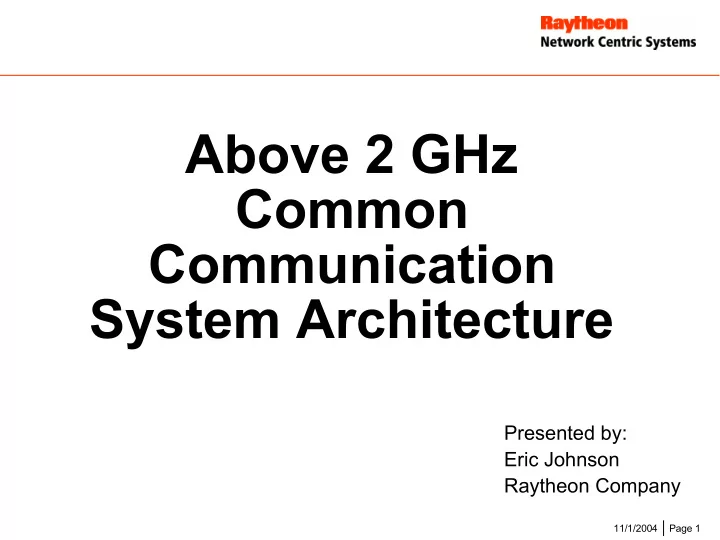

Above 2 GHz Common Communication System Architecture Presented by: Eric Johnson Raytheon Company 11/1/2004 Page 1
Presentation Overview • Network Architecture and Mission Overview • Challenges for above 2GHz System Architecture • Definition of Terms • Building an >2GHz Terminal • Managing Diverse Requirements • Functional Decomposition Methodology • Example Decomposition - Waveform • Component Validation • Next steps 11/1/2004 Page 2
Simplified Network Architecture Satellite Backbone Concentration layer >2GHz provides gateway Terminal between Backbone and Terrestrial >2GHz Networks. Terminal Terrestrial Voice and Data Networks 11/1/2004 Page 3
Mission Example – Remote Access >2 GHz COTM Terminal (Communications on the Move) >2GHz Base Station - Multiple Concurrent Applications - QOS Issues - High aggregate BW PSTN Access High Speed LAN (ex. GIG-E) - Single Application - Low Size/Weight/Power Server Farm Data Base 11/1/2004 Page 4
Challenges for >2GHz Architecture • Diverse Performance Requirements – Low Data Rates to 100’s Mbps (Broadband modulations requiring precision timing) • Requires integrated HW/SW solution – a Systems Solution • Diverse Service/Mission Requirements ( Air Force/Navy/Army) – Tactical vs. Strategic • Diverse Physical Constraints ( Size/Weight/Power )(SWAP) • Diverse Antenna Requirements • Diverse Mobility /Tracking Requirements – Communication-on-the-move to Stationary, narrow beamwidths • Diverse Security Requirements • Complex SATCOM waveforms • Simultaneous Multiband Capability � Top Priority on Extensible & Scalable 11/1/2004 Page 5
Working Definitions • Architecture – “The structure of components, their relationships, and the principles and guidelines governing their design and evolution over time”* • Waveform – The set of all HW/SW components required to implement the functions associated with interfacing to the Satellite(s). • Network – All HW/SW components required to implement the functions associated with interfacing to the ‘Baseband’ (Example EIA-422, Ethernet, T1) • Platform – All HW and SW components required to host/support a waveform and network to create a radio (e.g., BIT/BITE, antennas, etc.) • Control – Software associated with the external control and monitoring of the radio (UI, SNMP etc.) � Terminal = Waveform + Network + Platform + Control *IEEE STD 610.12, as extended by the Integrated Architecture Panel (IAP) of the C4ISR Integration Task Force (ITF) 11/1/2004 Page 6
Building a Terminal • Old Approach – Terminal specified as a monolithic entity for every Service – Specifications optimized for service capability and mission requirements – Emphasis on custom solution • New Approach – Terminal specified in terms of components – Platform, Waveform, Network, and Control – Component requirements support terminal requirements – Components are selected from libraries to satisfy functional and non- functional requirements (Portability/Extensibility/Scalability/Reusability) – The Terminal is built from derived platform, waveform, network, and control components 11/1/2004 Page 7
Managing Diverse Requirements Specification A Common Compromise Requirements • Simplified, generic requirements Waveform representation limited to platform and waveform Specification B Specification C • Specifications A, B, and C represent different Service Terminal requirements • Assume only one Waveform to keep � Platform and Waveform picture simple Must be Carefully and • Intersection of requirements is primarily Precisely Defined as due to Waveform Separate Entities Since Platform Can Be • Entire Waveform is not required by most Reconfigured to Support terminal specifications Different Waveforms 11/1/2004 Page 8
Decomposition Rules • Assign requirements to functions • Assign functions to components • Identify dependence of components on categories of requirements – Platform, Waveform, Network, Control • Reduce dependencies to single category – Develop components with capabilities that reduce dependencies (example - A tracking algorithm that works for a platform under motion should also work for a stationary platform!) – Push multiple dependency functions to lowest decomposition level to separate dependencies • Want common controls for platform, waveform, network, control or performance dependent objects 11/1/2004 Page 9
Decomposition Rules - Cont • Decompose to primitive component capabilities – Uses building block APIs – Enables portability of components – Enables flexibility to meet specific terminal requirements 11/1/2004 Page 10
Building a Terminal From Components • The Terminal is built from derived platform, waveform, network, and control components – Terminal components are assembled from SCA waveform, service, and device components Control Platform Waveform N Waveform 1 Network M Network 1 11/1/2004 Page 11
Validating Component Selection • Component Development and Validation Methodology Components Refinements are Made Based on Quality Attribute Scenarios Quality Attribute Applied to Use Case Realizations Scenario Functional Component Candidate Decomposition Choices Component Use Cases Use Case Realization Requirements � Selection of Components is an Iterative Process 11/1/2004 Page 12
Functional Decomposition Agreement • Agreement on Common Decomposition Across Platform, Network, Control and Waveform is Vital – Maximizes portability – minimizes porting costs – JTRS application SW is being developed using an evolutionary model to converge to a common decomposition – Approach avoids >2GHz application SW from being developed many times • Focus on broad definition of Re-Use – Component Requirements – Component Designs – Interface Specifications – Component Implementations (HW/SW) – Test Plans – Test Cases – Test Procedures 11/1/2004 Page 13
General Terminal Component Design • Terminal components should abstract the uniqueness of subcomponents – For example, a physical radio may contain 2 different antenna types, the antenna terminal component should make this transparent Generic Antenna Adapter Antenna Antenna Specific Specific SW1 SWn Antenna Control Software 11/1/2004 Page 14
Next Steps • Raytheon has been working with industry to define standards for below 2 GHz Software Defined Radios • Raytheon is contributing to the enhancement and extension of those standards to above 2 GHz capabilities – Providing comments to OMG RFIs and RFPs – Working on providing recommendations for additional and enhanced facilities • Continued efforts to refine optimal component sets • Work to extend validation methods and techniques – Develop simulation and common use case models 11/1/2004 Page 15
Recommend
More recommend